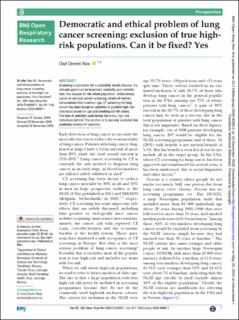| dc.contributor.author | Røe, Oluf Dimitri | |
| dc.date.accessioned | 2022-10-03T11:31:10Z | |
| dc.date.available | 2022-10-03T11:31:10Z | |
| dc.date.created | 2021-01-07T15:02:20Z | |
| dc.date.issued | 2020 | |
| dc.identifier.citation | BMJ Open Respiratory Research. 2020, 7:e000811 (1), 1-4. | en_US |
| dc.identifier.issn | 2052-4439 | |
| dc.identifier.uri | https://hdl.handle.net/11250/3023343 | |
| dc.description.abstract | Screening a population for a potentially deadly disease, the ultimate goal must be to prevent morbidity and mortality from this disease for the whole population. Unlike breast cancer or cervical cancer screening, where all women are screened after a certain age, CT screening for lung cancer has been based on selection of putative high-risk individuals based on age and smoking cut-off values. The type of selection used leaves too many high-risk individuals behind. The solution is to use only validated risk prediction models for selection | en_US |
| dc.language.iso | eng | en_US |
| dc.publisher | BMJ Publishing Group | en_US |
| dc.rights | Navngivelse-Ikkekommersiell 4.0 Internasjonal | * |
| dc.rights.uri | http://creativecommons.org/licenses/by-nc/4.0/deed.no | * |
| dc.title | Democratic and ethical problem of lung cancer screening: Exclusion of true high-risk populations. Can it be fixed? Yes | en_US |
| dc.title.alternative | Democratic and ethical problem of lung cancer screening: Exclusion of true high-risk populations. Can it be fixed? Yes | en_US |
| dc.type | Peer reviewed | en_US |
| dc.type | Journal article | en_US |
| dc.description.version | publishedVersion | en_US |
| dc.source.pagenumber | 1-4 | en_US |
| dc.source.volume | 7:e000811 | en_US |
| dc.source.journal | BMJ Open Respiratory Research | en_US |
| dc.source.issue | 1 | en_US |
| dc.identifier.doi | 10.1136/bmjresp-2020-000811 | |
| dc.identifier.cristin | 1867215 | |
| cristin.ispublished | true | |
| cristin.fulltext | original | |
| cristin.qualitycode | 1 | |

